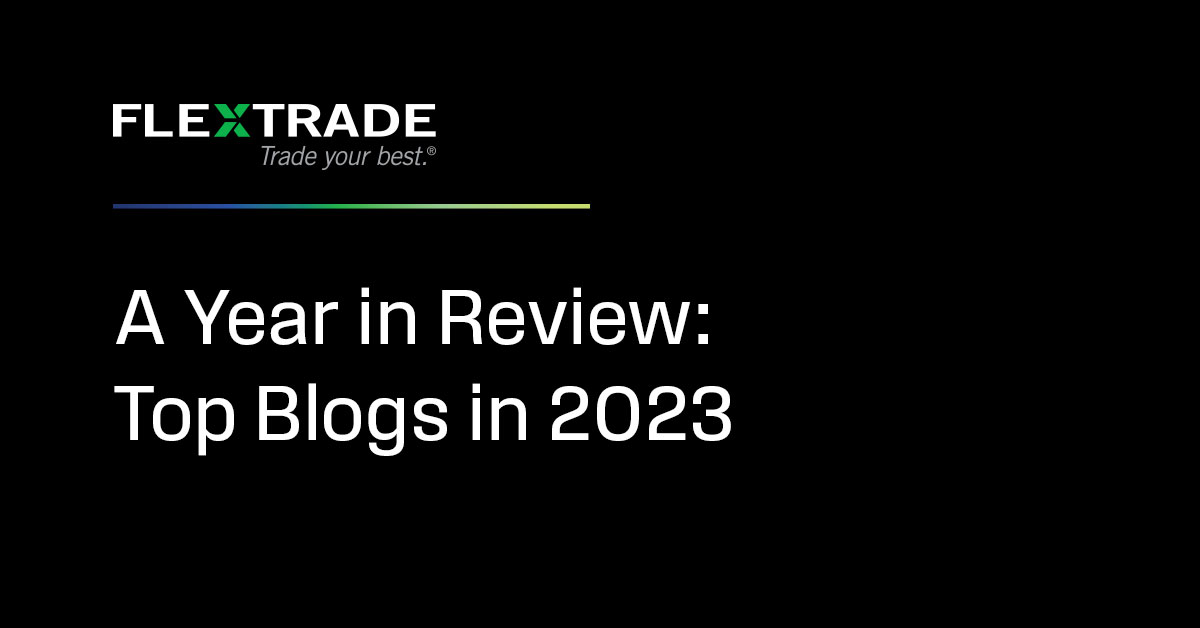A Year in Review: Top Blogs in 2023
December 13, 2023 | By: Ivy Schmerken

While the hottest topic in financial technology for 2023 was undoubtedly the rise of ChatGPT and large language models, other topics like consolidation of the buy-side trading desk and the impact of T+1 on the buy-and sell-side remained in serious contention.
As a leading front-office technology provider to the global institutional trading community, we’ve covered those topics and more in 2023. So which topics gained the most interest from readers?
Not unexpectedly, our top two articles centered around the two pivotal themes of 2023: the consolidation of the buy-side trading desk and ChatGPT. What’s Next for the Buy-Side Trading Desk explores the effort to consolidate multiple asset classes on a single EMS/OEMS, while Financial Firms Explore ChatGPT and Generative AI delves into use cases for ChatGPT in capital markets.
Rounding out the list are blogs covering key trends in fixed-income trading, sell-side trends in market structure, overnight trading, and the global implications of T+1.
Read on below for more details on the Top 10 Blogs in 2023:
- What’s Next for the Buy-Side Trading Desk
- Financial Firms Explore ChatGPT and Generative AI
- Key Trends in Fixed-Income Trading
- Top Sell-Side Trends for 2023
- Overnight Trading Gains Traction
- FDC3 Workflows to Unify the Financial Desktop
- T+1 to Impact Global Program Trading and FX
- Macro-Data Drives Hedge Fund Strategies
- Views on Bond Liquidity, Data and Automation
- Consensus Emerges in Industry Reaction to SEC Stock Trading Overhaul
1. What’s Next for the Buy-Side Trading Desk

According to comments by head traders at Fidelity, J.P. Morgan Asset Management and T. Rowe Price Investment Management, the future of the buy-side trading desk is moving toward multi-asset trading.
With uncertainty in the global economy, buy-side firms are looking to expand their product offerings into derivatives and build out multi-asset trading desks without necessarily increasing headcounts.
“Historically, firms have had trading separated between fixed income, options, and equities. The new trader may be asked to trade all of those together. So, we need the system and technology to support scalability,” said Tammy Wiggs, Head of Equity Trading at T. Rowe Price Investment Management, speaking on a buy-side panel.
2. Financial Firms Explore ChatGPT and Generative AI

With the frenzy around OpenAI’s ChatGPT technology and generative AI trained on vast collections of unstructured data to create large language models, there’s a race to experiment with these new tools in capital markets.
According to experts familiar with the technology, ChatGPT’s ability to rapidly summarize reports, filter, sort and rank massive quantities of information could boost productivity for traders, analysts and other finance professionals. “As we talk about the future of AI, it’s looking at efficiency and automated insights and then potentially freeing up resources for higher valued or higher skilled work,” said Kelly Fryer, Executive Director of FinTech Sandbox.
In May, FlexTrade launched a prototype for AI-driven functionality within its multi-asset execution management system FlexTRADER EMS that uses ChatGPT, known as FlexA (short for FlexAssistant). “By using plain spoken language, you don’t have to translate your thoughts into how a computer can understand it. You can just express yourself clearly in English or another language and it will interpret that and convert it into computer-readable instructions.” said Andy Mahoney, Managing Director, FlexTrade EMEA.
3. Key Trends in Fixed-Income Trading

In this Q&A with Matt Murphy of T. Rowe Price and Venky Vemparala of FlexTrade, the pair discuss how fixed-income trading desks cope with multiple trading protocols, venues, and vast data sets of pre-trade liquidity. Recognizing the impact of electronic trading, they delve deeper into conversations taking shape around data integration, automation, and interoperability.
“Data, automaton, AI, connectivity, liquidity, and interoperability are resonating with the buy side and across the industry,” said Matt Murphy, Fixed Income Electronic Trading and Market Structure Specialist at T. Rowe Price.
4. Top Sell-Side Trends for 2023

What are the top market structure issues for sell-side firms in 2023?
On the horizon are SEC proposed regulations to reform U.S. equity trading, increased best execution obligations, artificial intelligence, innovations in ATSs, 24-hour trading, and shortening the settlement cycle to T+1.
At the top of the agenda are the SEC’s proposals for overhauling equity trading rules which contain sweeping reforms that if enacted, will impact retail brokers and electronic market-market makers, and potentially shift certain retail orders to exchanges.
“The regulatory environment is probably the hot button topic right now and the biggest concern from a business perspective,” said the CEO of an institutional options trading firm at the STA annual market structure conference.
5. Overnight Trading Gains Traction

A surge in retail investor activity from Asia Pacific has translated into higher demand for trading U.S. stocks during the overnight hours, according to U.S.-based off-exchange trading venue operator Blue Ocean Technologies LLC.
Overnight trading volumes on Blue Ocean ATS have picked up this year as it expands connectivity to brokers in Asia Pacific and strikes partnerships with order management systems and market data distribution platforms.
“It’s been a confluence of factors including the emergence of crypto and the retail investor cohort which has been a real force in persuading people to consider adopting (overnight trading) – something they previously thought they would never want to do,” said Stephen Bombardiere, Managing Director – Head of Equity Trading at Mirae Asset Securities (USA) Inc.
6. FDC3 Workflow to Unify the Financial Desktop

With the proliferation of different financial applications on desktops, traders and portfolio managers often click and switch between multiple applications and rekey data, leading to potential errors and operational risk.
Now many investment banks and asset management firms are looking at FDC3, a standard facilitating interoperability of applications on the desktop, for connecting disparate applications and improving the user experience. Others see desktop interoperability as key to modernizing data infrastructure and legacy tech stacks.
“FlexTrade is helping to define the specific workflows for traders. For example, a trader who uses an EMS, OMS or OEMS may want to interact with an order, send a chat message to the PM, all while pulling up a chart from different applications and accessing a pre-trade cost model. Using the FDC3 standard, FlexTrade is mapping out the steps,” said Andy Mahoney, Managing Director at FlexTrade EMEA.
7. T+1 to Impact Global Program Trading and FX

As the US transitions to shortened settlement cycle next May, a major concern is how the tighter time frame will impact overseas fund managers trading U.S. equities given the time zone differences, particularly when a foreign exchange transaction is involved.
Time zone differences will make it tougher for institutions in Europe and Asia Pacific, which may need to change their work hours or hire additional operations staff to work a night shift.
“Not only is the settlement time going to become more compressed in the U.S., but it’s going to decrease more rapidly for non-US investment managers in Europe or Asia that are 5 hours or 12 or 14 hours ahead of U.S. markets,” said Matt McNamara, Managing Director and Head of Global Portfolio Trading at Raymond James. “That creates some ambiguity around the matching and settlement process for equity trading,” said McNamara.
8. Macro-Data Drives Hedge Fund Strategies

Financial markets are reacting to macro-events and news much faster than in the past, prompting hedge funds and other buy-side firms to hunt for new signals in data feeds.
The question is how are firms capturing these data feeds into their internal operations? Increasingly hedge funds are taking advantage of technology advances in APIs to integrate data feeds into their front-office trading systems, observed Jose Cortez, VP of Buy-Side Sales at FlexTrade.
“Hedge funds are asking about more macro data sets even if they’re not a macro-hedge fund they still need a view of the health of the consumer and interest rates,” said Chris Petrescu, CEO of CP Capital, a data consultancy to hedge funds.
9. Views on Bond Liquidity, Data and Automation

As hundreds of buy-side traders converged on Nashville for the Fixed-Income Leaders (FILs) event in May, Venky Vemparala discussed the major industry trends and challenges facing the buy-side around data, trading protocols, and automation. He touches on several advances within FlexFI, such as FISOR – a Fixed Income Smart Order Router, which taps into pre-trade liquidity, engages with all execution protocols and supports defined automation strategies in the trader’s quest for liquidity and best execution.
“Many firms are experiencing increased order flow, and want to scale up, but liquidity is the main worry. Liquidity is fragmented across protocols, each with their own rules of engagement. They want to see inside an EMS, the full picture of liquidity across all sources, venues and marketplaces. Trading efficiency is a concern here, and seamless access to all execution workflows is key,” said Venky Vemparala, FlexTrade’s Global Product Manager – Fixed Income.
10. Consensus Emerges in Industry Reaction to SEC Stock Trading Overhaul

Industry participants have weighed in on the Securities and Exchange Commission’s proposals to revamp equity market structure, with many urging the regulator to take an incremental approach, to implement the transparency proposal and drop the controversial auction proposal.
The industry’s letters also raised concerns about the complexity and sequencing of the SEC’s four massive proposals, and how they impact one another, which could lead to unintended consequences and operational or systemic risks.
At the Bloomberg Intelligence market structure conference in March, Dragan Skoko, Head of xBK and Outsourced Trading, said the proposals are all interrelated. “You have tick size changes, you have round-lot changes, you have introduction of auctions. What is hard to wrap your mind around is what is going to be the impact,” said the buy-side trader.